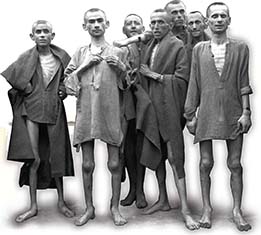SECTION 4: The Holocaust

▲ These starving prisoners at the Ebensee death camp in Austria were liberated by American soldiers.
WITNESS HISTORY  AUDIO
AUDIO
“I Have No Words”
On April 15, 1945, American radio listeners sat stunned as newsman Edward R. Murrow told of a horror beyond belief. Murrow was reporting about his visit to the Nazi concentration camp at Buchenwald. He described the emaciated, hollow-eyed prisoners, the stink which was “beyond all description,” the children with identification numbers tattooed on their arms, and the hundreds of “bodies stacked up like cordwood.” Toward the end of his report, Murrow said:
“I pray you to believe what I have said about Buchenwald. I have reported what I saw and heard, but only part of it. For most of it I have no words. Dead men are plentiful in war, but the living dead, more than twenty thousand of them in one camp…. If I’ve offended you by this rather mild account of Buchenwald, I’m not in the least sorry.”
—Edward R. Murrow, CBS Radio Broadcast, April 15, 1945
Objectives
- Trace the roots and progress of Hitler’s campaign against the Jews.
- Explore the goals of Hitler’s “final solution” and the nature of the Nazi death camps.
- Examine how the United States responded to the Holocaust.
Terms and People
- Holocaust
- Nuremberg Laws
- Kristallnacht
- genocide
- concentration camp
- death camp
- War Refugee Board
NoteTaking
Reading Skill: Recognize Sequence As you read, identify the steps that led to Hitler’s attempt to exterminate European Jews.

Why It Matters From the time he came to power, Adolf Hitler had targeted Jews for persecution. By the end of the war, the Nazis had murdered 6 million Jews and 5 million other people they considered inferior. Today, we continue to remember this tragedy and seek ways to prevent anything like it from ever happening again. Section Focus Question: How did the Holocaust develop and what were its results?
Roots of the Holocaust
What Edward R. Murrow saw at Buchenwald was just a fragment of the most horrific chapter of the Nazi era. In 1945, there was no word for it. Today, it is called the Holocaust, the Nazi attempt to kill all Jews under their control. The mass murders of Jews, as well as other “undesirables,” were a direct result of a racist Nazi ideology that considered Aryans (white gentiles, especially those of Germanic, Nordic, and Anglo-Saxon blood) superior to other people.
Hitler Preaches Hate
From the start, the Nazi movement trafficked in hatred and anti-Semitism. Hitler blamed Jews for all the ills of Germany, from communism to inflation to abstract painting—and, especially, for the defeat of Germany in World War I.
Other extremists influenced Hitler’s ideas and shared his prejudices. In the 1920s, his was just another angry voice in the Weimar Republic, advancing simplistic answers for the nation’s grave economic, political, and social troubles. In 1933, however, Hitler became chancellor of Germany.




